The historic Boboli Gardens are a must-visit for anyone traveling to Florence. This lavish garden is spread out around 45,000 square metres (11 acres) and serves as a picturesque backdrop for the iconic Pitti Palace. Its verdant expanse is steeped in centuries of history, adorned with refreshing greenery, iconic sculptures, and charming fountains.
The Boboli Gardens, despite its beauty and allure, is one of Florence’s lesser-known offerings, but it is located within a 2 km radius of the city’s well-known landmarks such as the Uffizi Gallery and the Galleria dell' Accademia. The Florence Duomo, an iconic cathedral set in the heart of the city centre, is a brief 10-minute walk from the Gardens!
Boboli Gardens - In a nutshell
Opening hours
The Boboli Gardens hours open at 8:15 AM but has different closing times based on the season:
- 4:30 PM in November, December, January and February
- 5.30 PM in March and October (without Daylight Saving Time)
- 6.30 PM in April, May, September, March and October (with Daylight Saving Time)
- 7.30 PM in June, July, August
Recommended Boboli Gardens tickets
Why Visit the Boboli Gardens?
- Largest open-air museum in Florence – With several old-fashioned buildings turned into museums and an array of historic statues and fountains – it is the largest open-air museum in Florence.
- Spectacular view of the Florence Duomo – The Florence Duomo is a 13th-century cathedral, known for its spectacular dome. The Boboli Gardens grant a mesmerizing view of the Duomo from a high angle, making it a favourite spot for tourists and explorers alike.
- Historical importance – The Boboli Gardens are steeped in centuries of history, having been developed over four centuries by reigning monarchs, architects, sculptors and artists.
- Breathtaking Green Architecture – Be it the branch archways along the Viale dei Cipressi (Cypress Lane) or the Upper Botanical Garden (Botanica Superiore), the Boboli Gardens takes the concept of green architecture a notch higher. The Ganymede Garden is also a must-see, with its mesmerizing fountain and a view to match.
- Central Location – These gardens are a part of Florence’s Historic Centre, which is listed as one of UNESCO’s World Heritage Sites. It is within walking distance from both the Piazza de' Pitti and the Piazza del Duomo – two of the most visited tourist spots in Italy.
- Florence’s best hike – If you love hiking, then the Boboli Gardens are the best place for an urban hike.. The 11-acre masterpiece is perfect for explorers to stroll amidst lush greenery, steep hills and well-maintained gardens.
- Proximity to Palazzo Pitti – The Boboli Gardens act as a backyard to the famous Palazzo Pitti and depending on the ticket you purchase, one can explore both the Gardens and the Palace at a discounted combo cost.
Boboli Gardens history under a minute

The Boboli Gardens were built by Cosimo I de' Medici, the second Duke of Florence and the first Grand Duke of Tuscany in the mid-16th century. The Garden gets its name from a variation of the land’s former owners – the Bogoli family.
The Boboli Gardens were among the first formal 16th-century Italian gardens and inspired many European establishments. The Gardens, located directly behind the Pitti Palace, features a host of mesmerizing sights including extraordinary statues and fountains and an awe-inspiring amphitheatre.
The sculptures, fountains and architectural wonders are breathtaking works of art by talented artists and sculptors like Niccolo Tribolo, Bartolomeo Ammannati, Giorgia Vassari, Bernardo Buontalenti and Giulio Parigi. These artists, commissioned by the Medici family, enriched the Gardens throughout the 17th, 18th and 19th centuries. It was opened to the public in 1766.
Boboli Gardens: Highlights
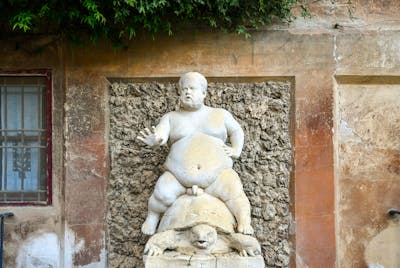
This fountain was designed by Valerio Cioli in 1560. It depicts a court dwarf, Braccio di Bartolo, naked and drunk while sitting atop a turtle representing Bacchus – the Roman God of wine.
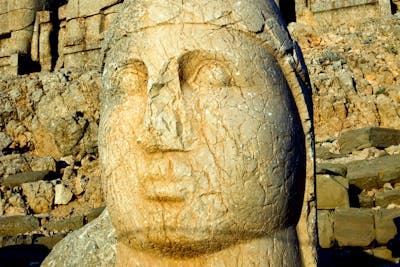
Hosted in the centre of the Boboli Gardens is the Tindaro Screpolato. Its sculptor,Igor Mitoraj, set out to express his yearning desire for a world that remains mysterious yet perfect through the statue.

An unmissable part of the Boboli Gardens is the Grotta Di Buontalenti – a cultural masterpiece named after its main architect Bernardo Buontalenti.

An unmistakable sight at the Boboli Gardens is the pastel green building topped off by a dome. Atop the Kaffehaus, visitors can admire the view of the entirety of the Gardens.
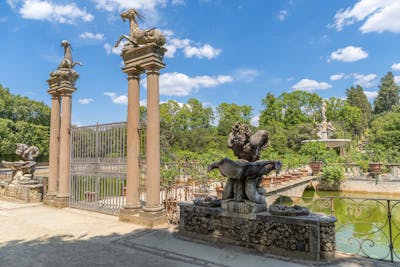
This basin hosts the Fountain of the Ocean with ornate fountains around the basin and a statue of Perseus emerging on a horse from under the water.
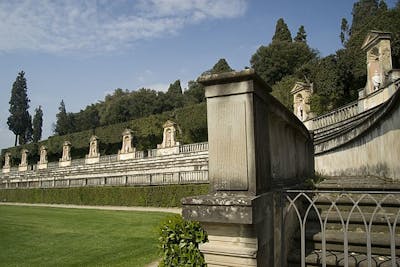
An old quarry turned into an innovative green amphitheatre, this space was used to host cultural festivals in the past. The Amphitheatre’s main features have now been restored to its former glory to give visitors a feel of its original form.
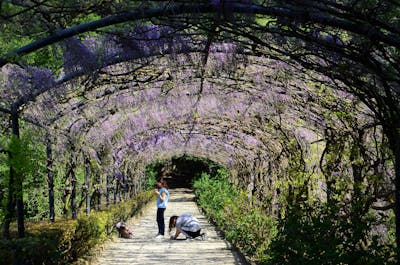
A short walk from the Boboli Gardens, the Bardini Gardens is a sprawling, yet underrated garden filled with gorgeous flowers, trees and architecture.
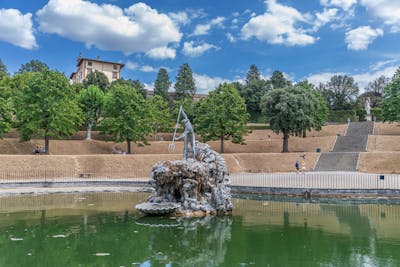
Climbing up Boboli Hill, visitors are graced with the Fountain of Neptune, a work by Stoldo Lorenzi. The masterful fountain features the God of the Sea wielding his trident.
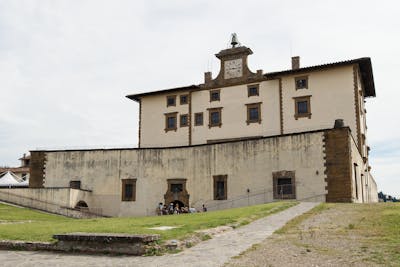
The largest fortress in Florence, the Forte Belvedere stands on the highest hill of the Boboli Gardens. It offers visitors a mesmerizing view of Florence along with an intriguing look into Renaissance architecture.

The Viottolone (Grand Boulevard) is a long road lined by cypresses, old oak trees and other ancient trees. It is the newest part of the garden, having been added in 1600, and is a relaxing place to stroll while admiring nature.
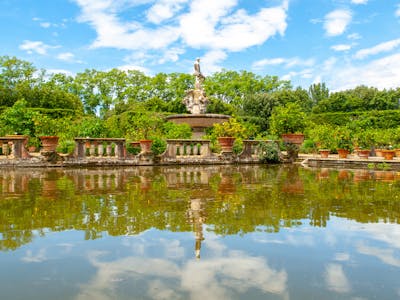
A large pond with an island in the middle hosts the Fountain of The Ocean with a statue of Neptune as its centrepiece surrounded by three deities to represent the Nile, Ganges and the Euphrates.
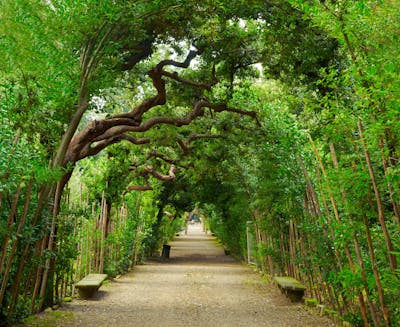
Known as Spiders Lane, this long pathway is covered by archways made of branches the perfect spot for a leisurely stroll.
Boboli Gardens - Essentials
Boboli Gardens - Timings
The Boboli Gardens are open seven days of the week throughout the year except for January 1, December 25 and the first and last Monday of each month.
The Boboli Gardens hours open at 8:15 AM but has different closing times based on the season:
- 4:30 PM in November, December, January, and February
- 5.30 PM in March and October (without Daylight Saving Time)
- 6.30 PM in April, May, September, March, and October (with Daylight Saving Time)
- 7.30 PM in June, July, and August
Keep in mind that the Gardens may experience temporary closures in the event of emergencies, so do check once before you go!
How to reach Boboli Gardens?
- By car: Visitors travelling through Florence by car can use the city’s many parking spaces, located close to popular tourist attractions. The same applies to the Boboli Gardens, although there are barely any free parking spaces so prepare to pay up. Visitors can also hire taxis but these can be quite expensive.
- By bus: There are scheduled buses from several stations across Florence which take you directly to the Boboli Gardens. Direct buses are available from Oltrande area , Firenze Santa Maria Novella Station and Piazzale Michelangelo. Bus travel is relatively cheap and convenient.
- By train: The closest train station to the Boboli Gardens is the Santa Maria Novella Station,a 15-minute walk away from the Gardens. The station serves most major train lines so visitors can take trains from Rome or other parts of Italy.
- By walk: Exploring Florence by foot is an adventure by itself. Visitors can stroll through the city’s many stunning offerings, most of which are walking distance from each other.
Boboli Gardens: Visiting tips
- We recommend exploring the gardens and surrounding areas by foot so you can take your time to marvel at the extraordinary Renaissance and Roman architecture.
- Visitors should ideally reserve at least five to six hours if they want to thoroughly explore everything the Garden has to offer.
- Do not miss the chance to visit the Porcelain Museum and the Kaffehaus during your visit to the Gardens.
- The Bardini Gardens, next door to the Boboli Gardens, are equally stunning for nature lovers.
- If you visit the Boboli Gardens in the summer, we recommend doing so in the early morning before the afternoon hits.
- Those eager to avoid lines should grab Skip the Line access tickets online. To explore Boboli and its surrounding areas thoroughly, visitors are advised to buy the Passepartout 3 Days pass for 18€ which allows them entry into the Gardens, the Pitti Palace and the Uffizi Gallery for 3 consecutive days.
- Italian residents and those who frequent Florence, either solo or with their families, can buy an annual pass. This pass gives them unlimited priority admission into the Gardens, Uffizi Gallery and Palazzo Pitti. A single annual pass costs € 70 while the family pass, which admits 2 adults and unlimited children, is available for € 100.
- While photography and filming for private use are allowed, shooting for professional use or publication requires special permission.
- Lastly, visitors should keep in mind that although it is a vast green area, the Boboli Gardens are a historical site. Activities that damage the area and its artefacts will result in lead to strict action against the violators.
FAQs
How long does it take to visit the Boboli Gardens and Pitti Palace?
When is the best time to visit the Boboli Gardens?
Can I buy Boboli Garden tickets on-site?
Can I book Boboli Garden tickets online?
Is Boboli Garden free?
Are the Boboli Gardens worth it?
Are the Boboli Gardens gardens still lush in the winter months?
Can I bring pets into the Boboli Gardens?
Can you picnic in Boboli Gardens?
Is there a combo ticket to see the Boboli Gardens and the Pitti Palace?
How do you get into Boboli Gardens?
How much time do you need at Boboli Gardens?
Is the Boboli Gardens accessible for those with reduced mobility?
Are there guided tours of the Boboli Gardens?


